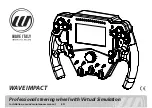
Series 94 Quick Reference
Keys and Displays
Alarms
The
process alarm
sets an absolute temperature. When the actual temperature exceeds that absolute temperature an alarm occurs. The
process alarm set points may be independently set high and low. Under the Setup Menu, select the type of alarm output with the
[`Ot2]
Output 2 parameter.
[`PrA]
sets a Process Alarm with alarm message displayed.
[``Pr]
sets a Process alarm with no alarm message
displayed.
Latching:
Alarms can be latching or non-latching. When the alarm condition is removed a
non-latching alarm automatically
clears
the alarm output. You must
manually clear a latching alarm
before it will disappear by pressing the Reset key.
To clear an alarm:
First correct the alarm condition, then…
•
If the alarm is latching:
Clear it manually by pressing the Reset key once as soon as the process temperature is inside the alarm limits and satisfies the alarm
hysteresis
[`HSA]
.
•
If the alarm is non-latching:
The alarm clears itself automatically as soon as the process temperature is inside the alarm limits and satisfies the alarm hysteresis
[`HSA]
.
Flashing
[`LO`]
or
[`HI`]
in the lower display indicates an
alarm when
[`Ot2]
is set to
[`PrA]
. The lower display alter-
nately shows information from the current parameter and the
[`LO`]
or
[`HI`]
alarm message at one second intervals. The
alarm output is de-energized and the Output 2 indicator light is
lit.
Alarm Silencing
is available with the process alarm and has two uses:
When
[`SIL]
is selected as “on,” the controller automatically disables the alarm output on initial power up (in either the latching or non-
latching mode). Alarm silencing disables the alarm output relay and the Output 2 indicator light. Once the process value crosses into the
“safe” region, both a latching or a non-latching alarm is ready. Any future excursion outside of these alarm set points triggers an alarm.
When
[`SIL]
is selected as “on,” pressing the Reset Key will disable the alarm output relay and the indicator light once an alarm has
occurred, but will not eliminate the alarm message if enabled. (If
[`Ot2]
is set to
[`PrA]
.) This silences the alarm until the process
returns to the “safe” region. Once within this region, the alarm is ready again. Any future excursion outside of the alarm set points trig-
gers an alarm.
Errors
Three dashes
[`---]
in the upper display indicate a Series 94 error. The error code is visible in the lower display.
[`Er2]
- Sensor underrange error (applies only to RTD units)
The sensor input generated a value lower than the allowable signal range, or the A/D circuitry malfunctioned. Enter
a valid input. Make sure the
[``In]
Input parameter (Setup Menu) and the DIP switch settings both match your
sensor. Refer to the table below for the appropriate input type and range.
[`Er4]
- Configuration error
The controller’s microprocessor is faulty; call the factory.
[`Er5]
- Non volatile checksum error
The nonvolatile memory checksum discovered a checksum error. Unless a momentary power interruption occurred
while the controller was storing data, the nonvolatile memory is bad. Call the factory.
[`Er6]
- A/D underflow error
The A/D circuit is underrange. An open or reversed polarity sensor is the most likely cause. Check the sensor; if the connection is good and
functions properly, call the factory. The A/D underrange voltage is too low to convert an A/D signal. Make sure the
[``In]
Input parame-
ter (Setup Menu) matches your sensor and DIP switches are set accordingly.
[`Er7]
- A/D overflow error
The A/D circuit is overrange. An open or reversed polarity sensor is the most likely cause. Check the sensor; if the connection is good, and
the sensor functions properly, call the factory. The A/D overrange voltage is too high to convert an A/D signal. Make sure the
[``In]
Input parameter (Setup Menu) matches your sensor and DIP switches are set accordingly.
Lower Display:
Can indicate actual temperature, alarm low,
alarm high, limit low set point value, limit high set point
value, operating parameter values or an open sensor. When
powering up, the lower display will be blank for five seconds.
• To set to blank: set
[`bot]
to
[`no`]
in the Setup Menu.
RESET Key
• Press once to clear any limits or latched alarms.
• Press once to silence alarm output if silencing is
enabled.
• Automatic reset on power loss.
Output 1 Indicator Light:
Lit
when limit output is tripped.
Upper Display:
Can indicate actual temperature, alarm low, alarm high, limit low
set point value, limit high set point value, operating parameter values or an open
sensor. When powering up, the upper display will be blank for five seconds.
• To set to blank: set
[``UP]
to
[`no`]
in the Setup Menu.
Advance Key:
Press to step through the
Operation, Setup and Calibration Menus.
LIMIT 94
Output 2 Indicator Light:
Lit
when alarm output is tripped.
Up-arrow and Down-arrow Keys:
Increases or decreases the value of the displayed parameter.
• Press lightly to increase or decrease the value by one.
• Press and hold down to increase or decrease the displayed value at a rapid rate. New data will self-enter in
five seconds, or can be entered by pressing the Advance Key.
• Press both simultaneously for three seconds to enter the Setup Menu. The
[`LOC]
parameter appears.
• Continue pressing both keys for three seconds to enter the Calibration Menu.
RESET
W a t l o w S e r i e s 9 4
A p p e n d i x
■
A . 1 3
Appendix
LIMIT 94
RESET
LIMIT 94
RESET
RESET
LIMIT 94
Press once to
clear a
latched and
corrected
alarm.
Содержание Series 94
Страница 4: ...Watlow Series 94 Notes...
Страница 6: ...Overview 1 2 Overview Watlow Series 94 Notes...
Страница 16: ...3 2 Keys and Displays Watlow Series 94 Keys and Displays Notes...
Страница 30: ...A 6 Appendix Watlow Series 94 Appendix Notes...




































